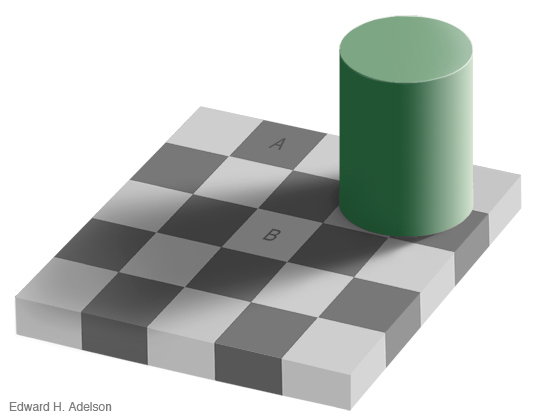Alessandro Farini, head researcher of the Visual Ergonomy Lab at the CNR-National Institute of Optics in Florence, Italy, shares in this UN International Year of Light blog entry the impact of lighting on visual perception.
It is impossible to separate our vision from light, but the relationship between light, vision and perception is not completely clear nowadays. We can see an object because the light hits the object, the object reflects some wavelengths and part of the electromagnetic radiation can reach our retina, but the result is very complex, and a huge part of the process of vision happens inside our brain. Our retina is something completely different from the CCD of a photographic camera, because in a certain sense the retina is a part of a brain that can pre-process the light signal.
 |
|
Adelson Checkboard. (Photo Credit: Edward H. Adelson) |
Look for example at the famous Adelson Checkboard (see Figure above). From a physical point of view squares A and B have the same luminance (quantity of light that can reach the sensor of an instrument) but the brightness (perceived quantity of light) is completely different. So, light measured from an instrument and light perceived from the brain are two different things. This fact should be taken into account in many different fields: lighting design, colour rendering of smartphone monitor, colour reproduction and so on.
Such an observation could be an introduction about a never ending philosophical discussion: is our reality subjective or objective? But the main theme is that it is impossible to separate reality from our perception: I’m Italian, so probably the best way to describe this link is using the words of Dante Alighieri in Divina Commedia (l’uomo da sensato apprende ciò che fa poscia d’intelletto degno (since only in perceiving through the senses can they grasp that which they then make fit for intellect. Par.IV 41-42), a quotation that recall the scholastic philosophy Nihil est in intellectu quod non prius fuerit in sensu (Latin for “nothing in the intellect without first being in the senses”).
Light is an important part of our perception. Changing light that hits an object can change the perceived color of the object, but if the story is over the color of an object is simply something that does not exist. Our car, our tshirt, our trousers should change color from the morning to noon, from noon to afternoon, from afternoon to indoor lighting. Luckily, we have a skill, named color constancy, which ensures that the perceived color of objects remains relatively constant under varying illumination conditions. So we can readapt our vision under different lightings.
The continuous reinterpretation of light made by our visual system is a proof that vision (or knowledge, more in general) is something that involves a subject and an object. To see something you need to look at it, but you need also to take into account your mind, your experience. You can observe the same painting after twenty years, the same light reach your retina, but you perceive something different. Because everything is in a context, not isolated. Due to this link, studying light and its relationship with human vision is a never ending process. The more our researches advance, the more the supposed arrival point becomes a new starting point for us, studying light in this International Year of Light 2015 and also for the posterity.












